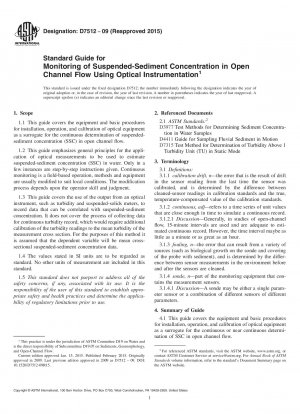ASTM D7512-09(2015)
Standard Guide for Monitoring of Suspended-Sediment Concentration in Open Channel Flow Using Optical Instrumentation
- Standard No.
- ASTM D7512-09(2015)
- Release Date
- 2009
- Published By
- American Society for Testing and Materials (ASTM)
- Status
- Replace By
- ASTM D7512-09(2023)
- Latest
- ASTM D7512-09(2023)
- Scope
5.1 This guide is general and intended as a planning guide. To satisfactorily monitor a specific site, an investigator must sometimes design specific installation structures or modify those given in this guide to meet the requirements of the site in question. Because of the dynamic nature of the sediment transport process, the extent to which characteristics such as mass concentration and particle-size distribution are accurately represented in the monitoring program depends on the type of equipment used and method of collection of the SSC samples used to calibrate the optical readings. Sediment concentration is highly variable in both time and space. Numerous samples must be collected and analyzed with proper equipment and standardized methods for the rating of the optical equipment at a particular site (see Guide D4411 and Practice D3977).
5.2 All optical equipment have an upper limit for valid readings, beyond which the meter will not read properly, commonly referred to as “blacking out.” If upper range of SSC are expected to cause optical instrument black out, then some other means should be devised, such as automatic pumping samplers, to collect samples during this period. See Edwards and Glysson (1)3 and Glysson (2) for information on collection of suspended sediment samples using pumping samplers. It should be noted that other technologies, such as lasers and acoustic dopplers, are also being used to monitor SSC continuously.
5.3 The user of this guide should realize that because different technologies and different models of the same technology of turbidity meters can produce significantly different outputs for the same environmental sample, only one manufacturer and model of the turbidity meter can be used to develop the relationship between the SSC and turbidity readings at a site. If a different manufacturer or a different model type of turbidity meter is used, a new relationship will need to be develop for the site.
1.1 This guide covers the equipment and basic procedures for installation, operation, and calibration of optical equipment as a surrogate for the continuous determination of suspended-sediment concentration (SSC) in open channel flow.
1.2 This guide emphasizes general principles for the application of optical measurements to be used to estimate suspended-sediment concentration (SSC) in water. Only in a few instances are step-by-step instructions given. Continuous monitoring is a field-based operation, methods and equipment are usually modified to suit local conditions. The modification process depends upon the operator skill and judgment.
1.3 This guide covers the use of the output from an optical instrument, such as turbidity and suspended-solids meters, to record data that can be correlated with suspended-sediment concentration. It does not cover the process of collecting data for continuous turbidity record, which would require additional calibration of the turbidity readings to the mean turbidity of the measurement cross section. For the purp......
ASTM D7512-09(2015) Referenced Document
- ASTM D3977 Standard Test Methods for Determining Sediment Concentration in Water Samples
- ASTM D4411 Standard Guide for Sampling Fluvial Sediment in Motion
- ASTM D7315 Standard Test Method for Determination of Turbidity Above 1 Turbidity Unit (TU) in Static Mode
ASTM D7512-09(2015) history
- 2023 ASTM D7512-09(2023) Standard Guide for Monitoring of Suspended-Sediment Concentration in Open Channel Flow Using Optical Instrumentation
- 2009 ASTM D7512-09(2015) Standard Guide for Monitoring of Suspended-Sediment Concentration in Open Channel Flow Using Optical Instrumentation
- 2009 ASTM D7512-09 Standard Guide for Monitoring of Suspended-Sediment Concentration in Open Channel Flow Using Optical Instrumentation

Copyright ©2024 All Rights Reserved